3 scenarios for the future of research – which is most likely?
March 20, 2019 | 11 min read
By Alison Bert, DMA
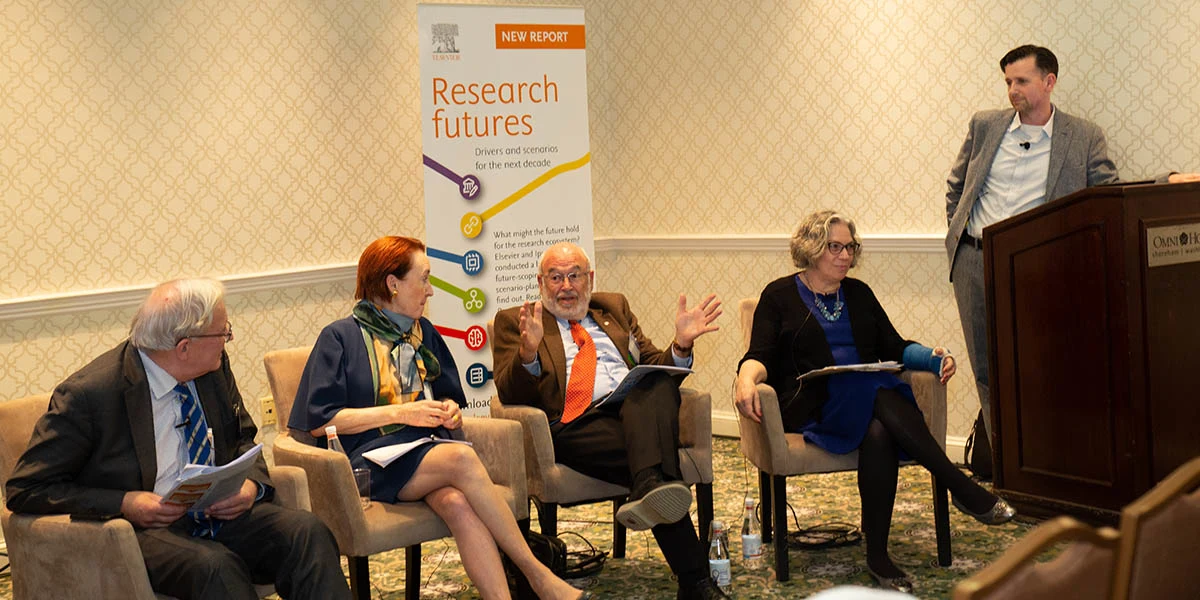
Experts at AAAS weigh in on the new Research Futures study by Elsevier and Ipsos MORI
Caption: Experts debate the future of research at an interactive panel at the AAAS Annual Meeting in Washington, DC (from left): Dr. Peter Tindemans, Secretary General of EuroScience; Mary Woolley, President and CEO of Research!America; Prof. Sir Peter Gluckman, President Elect of the International Science Council; Dr. Joanne Tornow, Assistant Director for Biological Sciences at the National Science Foundation and, at the podium, Adrian Mulligan, Research Director for Customer Insights at Elsevier. (Photos by Alison Bert)
Imagine yourself 10 years from now. It’s 2029, and the world of research has changed – dramatically for some of you. But how?
Where will your research funding come from? Will your collaborators be academics or colleagues at a tech company?
Will you use artificial intelligence to determine your research hypothesis – and will journals use AI to decide whether to accept your paper? Will that “paper” even look like the manuscript you’re used to submitting?
If you’re a professor, will your students come to the university or study from afar?
These are just a few of the questions the new Research Futures scenario-planning study delves into. To forecast how research might be created and exchanged 10 years from now, investigators from Elsevier and Isos MORI examined the literature and market drivers, interviewed over 50 funders, futurists, publishers and technology experts and surveyed more than 2,000 researchers.
From the analysis, key themes emerged. The investigators then held creative workshops, and participants used this knowledge to develop three plausible scenarios of the future:
Brave open world considers the rise of open science.
Tech titans looks at the growing influence of technology.
Eastern ascendance considers the role the East – and China in particular – might play.
Elsevier colleagues initially conceived this project to gain insights into how they could collaborate with the research community to build a better information system supporting research.
“We needed some information to inform our own decisions as an information analytics provider,” said Hannfried von Hindenburg, SVP of Global Communications, in introducing the panel. “But we felt we should make it public so that all of you could make your decisions based on this research.
“It’s meant to stimulate a discussion, and it’s meant to stimulate decision-making.”
That conversation continued when the report was released at the Annual Meeting of the American Association for the Advancement of Science (AAAS) in Washington, DC. A panel of research leaders – along with researchers in the audience – weighed in on which scenarios seemed most likely.
“Since we’re envisioning the future, there are no wrong answers,” said moderator Dr. Brad Fenwick, SVP of Global Strategic Alliances at Elsevier.

Hannfried von Hindenburg, SVP of Global Communications at Elsevier, introduces the report and panel at AAAS.
Exploring the future through a 3D lens
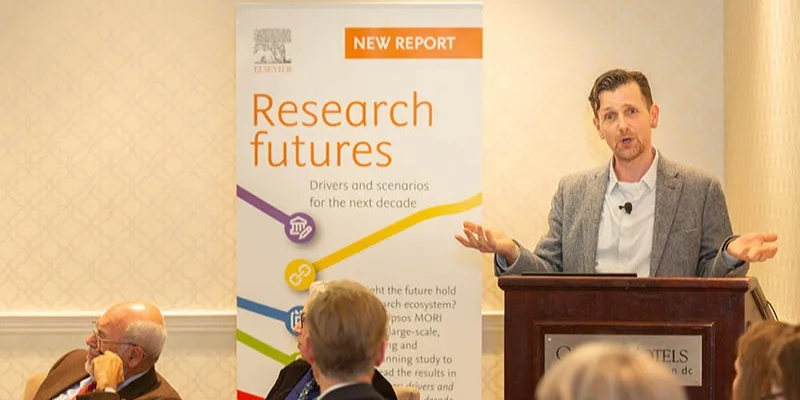
Adrian Mulligan summarizes key themes and scenarios in the report before seeking input from the panel and audience.
In his introduction to the report, lead investigator Adrian Mulligan, Director of Research for Customer Insights at Elsevier, summarized the key points – starting with the “three dimensions” the experts used to contemplate the future.
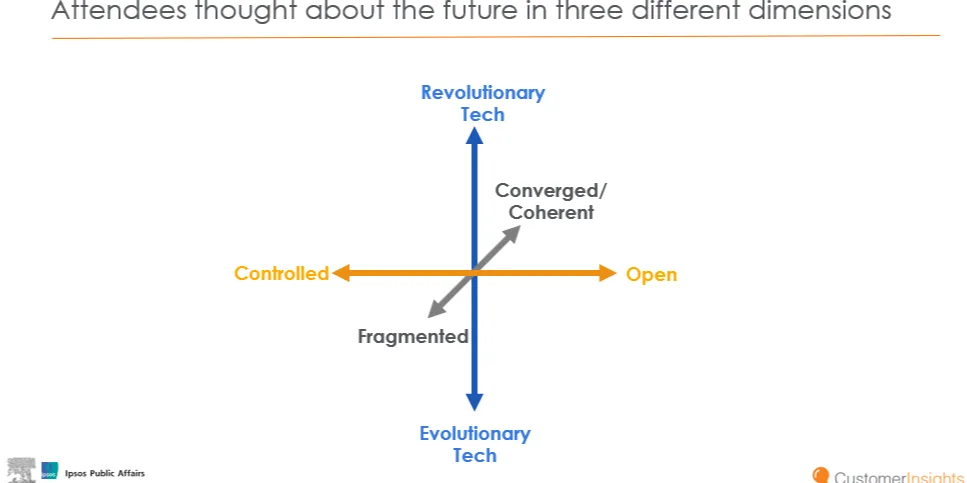
Three dimensions were used to contemplate the future: the progress of technology (blue); the degree of openness and sharing of research (orange); and those who support research and whether they would be aligned or fragmented (grey).
Blue represents the world of technology. “On one extreme, technology is revolutionary and drastically alters the way science is done,” Mulligan explained. “On the other, evolutionary tech is just like it is now, steadily progressing.”
Orange, meanwhile, represents the exchange of research and data and the degree to which it will be open or controlled, and gray represents whether organizations or nation states are aligned or fragmented.
Each of these elements combines with the others in a distinct way in the three future scenarios.
Scenario 1: Brave open world
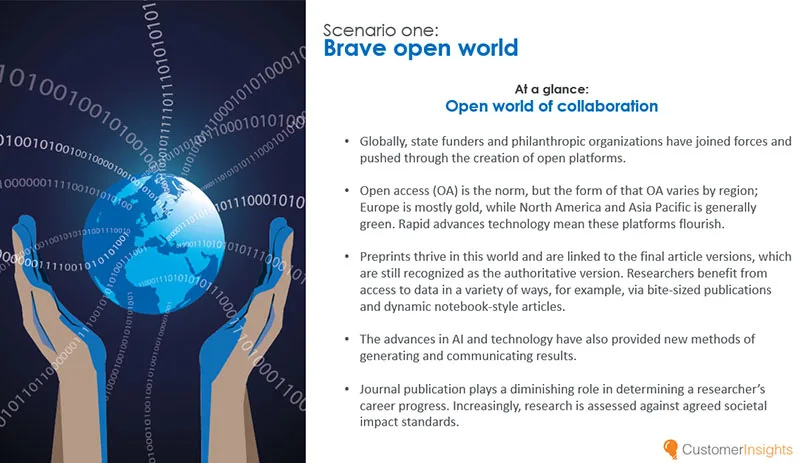
In the Brave open world scenario, various factors converge for open collaboration.
“Brave open world” is characterized by open sharing of research, revolutionary technology and more convergence among stakeholders, Mulligan explained. For example, big tech partners with funders and research institutes to develop interoperable machine learning tools and platforms.
“In this scenario, all the actors and funders … come together to create an open platform in which science is shared,” he said. “Research articles are all open access, and the research article moves on from the current format to a more dynamic ‘notebook’ style that is more atomized and broken up.”
In addition, AI accelerates the speed and volume of research, and researchers are rewarded by a range of measures, including interdisciplinary collaboration, data dissemination and social impact.
Trust in science has increased because the public has greater access to published science, and researchers are expected present their work in a way that’s understandable to the lay person.
Scenario 2: Tech titans
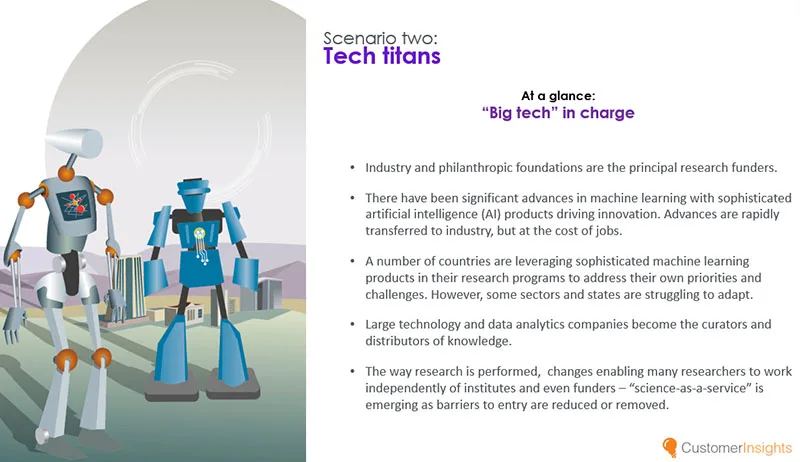
In the Tech titans scenario, big tech companies take charge of the research landscape.
The “Tech titans” scenario is characterized by revolutionary technology, with the large tech companies becoming the main supporters, curators and distributors of knowledge. “The big technology companies step in and play a key role in the communication of science and the funding of research,” Mulligan said. “There are massive advances in AI in this world. Here, we see AI play such an important role that it changes society in essential ways. There are lots of job losses … in research as well.”
Much of research has become automated, driven by AI and data mining, and AI enables data-driven hypothesis generation – a practice we’re already experimenting with. Researchers often work closely with industry as independent consultants for large corporations.
Data sharing and machine learning have supported successful commercial breakthroughs, and the platforms the tech companies create have lowered the cost of doing research. However, there are concerns about data being held by private companies and not being made public – or medical advances not being evenly distributed. That competitive drive would likely spill onto the global stage.
“A number of countries are competing to deploy artificial intelligence, keeping it close to their chests in terms of the knowledge they have acquired in developing of new products,” Mulligan said. “And we find some countries struggling to adapt to making use of these new technologies.”
Meanwhile, it’s a politically fragmented world; state funding for research has been reduced, and industry and philanthropic organizations have stepped in to fill the gap, investing in challenge-led science.
Scenario 3: Eastern ascendance
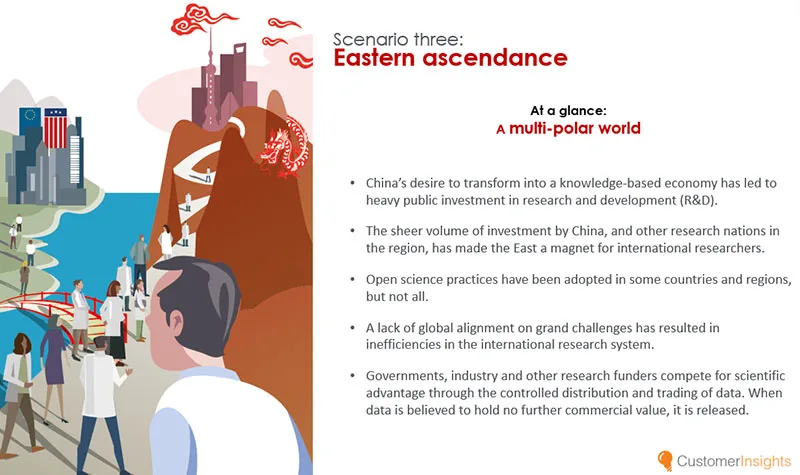
In the Eastern ascendance scenario, China’s desire to transform into a knowledge-based economy has led to heavy public investment in R&D.
The third scenario – Eastern ascendance – is also a fragmented world, with a sharp division between the United States and China. “China has invested massively into research and development, and it’s really paying dividends for them,” Mulligan said. “In the West, we’re unable to keep up with what China is doing, and as a consequence, the sheer volume of that investment is really shaping the way research is being communicated and the advances that are being made.
“Actually, the world changes so much that China becomes a magnet for western researchers. So rather than Western researchers going to Oxford or MIT or the top universities in Europe, they’re heading towards China.
“Open science is embraced in this world,” he continued, “but only partly embraced because it’s quite a fragmented world. People are trying to take commercial advantage of the data and science that’s been communicated, so there’s a lack of global alignment on research projects. Everyone’s trying to do things in their own way.”
As a result, products like self-driving cars, or developments in personalized medicine, are not universally available.
In publishing, the Impact Factor continues to prevail and the subscription model plays a role. Meanwhile, big tech companies form partnerships with publishers to provide AI-enabled workflow and publishing tools.
Researchers or technology: which will drive new knowledge?
For the rest of the workshop, Dr. Fenwick posted questions from the survey, and audience members used their smart phones to register their answers in Menti. For example:
Question: “In 10 years, the creative force driving forward new knowledge will be …”
Answer: Researchers – Technology – Either equally likely
Mulligan started by alluding to the “robust intelligence of the ‘tech titan’ world” and the expanding role of AI in driving research: Could AI become so advanced that it could create new science? “We had a number of experts say that much of the hypotheses being generated will be coming from machines rather than humans,” he said. “The role of technology has the the potential to transform research.”
Two panelists challenged the question itself.
"The real idea underlying this statement is that AI will replace researchers completely, and this will not be the case," said Dr. Peter Tindemans, founding member and Secretary General of EuroScience.
“I think it depends how you look at this,” said Prof. Sir Peter Gluckman, President Elect of the International Science Council and former Chief Science Advisor for the Prime Minister of New Zealand. He referred to Prof. Dan Sarewitz’s 2016 essay “Saving Science” in The New Atlantis:
As Dan Sarewitz suggests … science is driven by technological development. Until the microscope was invented, you couldn’t look at the cell – etcetera, etcetera, etcetera. … Always new technologies allow new questions to be answered. So by definition, much science is driven ultimately by technological possibilities.
Dr. Joanne Tornow, Assistant Director for Biological Sciences at the National Science Foundation, countered with a vote for the researcher:
Technology by itself doesn’t answer the questions. It’s the researcher. … You have to have the technology – I agree. And technology is as disruptive and as transformational as an aha moment in understanding. But it doesn’t in and of itself solve a problem.
Dr. Fenwick then asked: “Where will the new idea to do the research come from? Where will the idea for the hypothesis come from? (How will it be decided whether) it’s worth researching? Will this be in silico or will it still be the PI that comes up with the idea?”
Dr. Tornow responded with still another question: “Where does new technology come from? New technology comes from ideas that researchers have. It’s kind of a virtuous cycle.”
Dr. Fenwick agreed that technology is often developed to meet the needs of science: “You wouldn’t build a collider if you didn’t have the scientific community saying I need this tool to answer this question.”
Then he played devil’s advocate: “On the other hand, I could make an argument that if we can’t digest all the science, but a machine can through machine learning, what if a machine came up with a question or hypothesis or a question worth asking and answering? Would we accept it?”
Not only would we accept it; researchers who enable their questions to be generated by AI would have a competitive advantage, Prof. Gluckman said. “Those researchers who do big data and use big-data tools tend to write papers that get into high impact journals,” he said. “And funders love big-data-based, meta-analysis type research.”
As the “chicken-and-egg” aspect of this conundrum became increasingly apparent, a woman in the audience aptly pointed out, “Someone had to write the algorithm.”
Ultimately, the panelists as well as the audience voted more in favor of researchers.
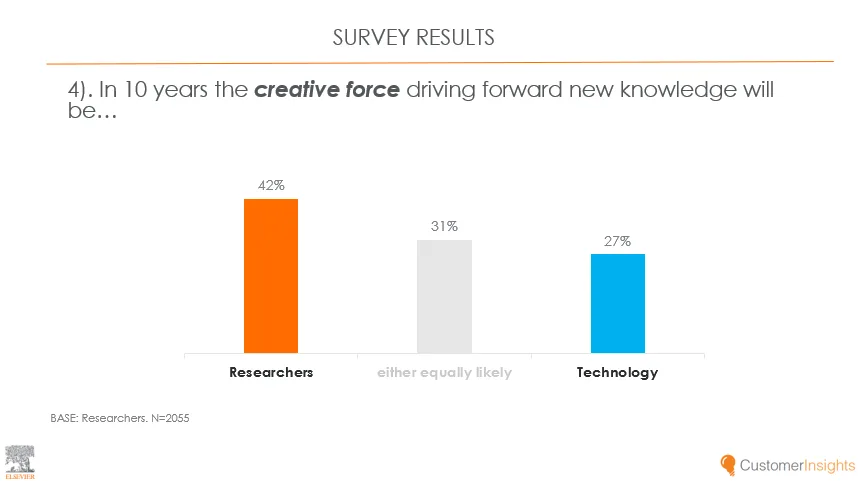
In the Research Futures survey of researchers, the most popular response was ‘researchers.’
Will students actually go to universities?
The next question dealt with the rising trend of distance learning in higher education:
Question: “In 10 years, university student will be educated …
Answer: Mostly on campus – Mostly remotely – Either equally likely.
Dr. Tindemans said there are pressing reasons for students to be on campus:
Students go to a university not just to learn something. Secondly, in many areas of study, you need to work together with your professors by doing experiments (and) other things together, and that is very difficult to organize another way. And the third thing is simply the status: a diploma is a link to what university and not just to a collection of exams you have passed online.
Mary Woolley, President and CEO of Research!America, said the answer depends on the university and subjects being studied:
I would say there’s a context … of elite vs non-elite university and college institutions and education. For the elite, students would be more likely on campus. But for all the rest, which is a much higher percentage, I would think it would be increasingly remotely.
Dr. Fenwick pointed out that more elite universities in the US are “making a bet that they can do more distance learning.” As an example, he mentioned a university that bought a large education company, using Elsevier to create their learning platform.
Prof. Gluckman agreed that university education is likely to change, with a rise in interdisciplinary and team-based research, but added that other as yet uncertain factors would also impact these future scenarios. Prof. Gluckman foresees the probability of a more focused investment of government funding in a smaller proportion of research-intensive universities, with the other universities becoming more education-focused and offering more distance-learning options for current and continuing education. However, it’s not clear what form “lifelong re-learning and retraining” will take for many people, he said, “and I think we’re still a decade away from understanding how that’s going to evolve.”
Woolley mentioned “competing pressures” that could turn the tide either way: “the move toward interdisciplinary work and team science that really does require (in-person) interaction” versus the fact that “we’re getting much, much better at connecting remotely.” Ultimately, she said, it would depend on what fields people are studying, some of which will still require a presence on campus.
Similar to the panel’s responses, the audience’s were equally divided, as were those of the researchers who took the survey:
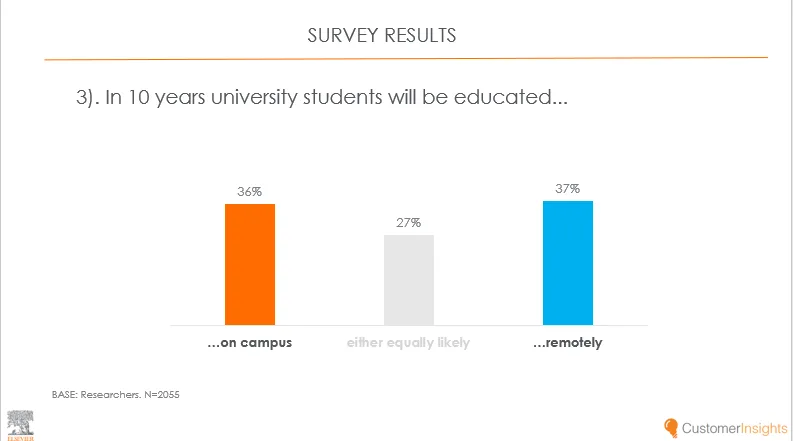
In the Research Futures survey of researchers, responses were divided almost equally.
“The best way to influence the future …”
In reflecting on the topic and what was learned from the study, Mulligan said: “You can think about the future, but the best way to influence the future is to create the future.”
Download the report and supporting material
The report Research Futures: drivers and scenarios for the next decade is freely available.
Elements of the underlying study data are also freely available:
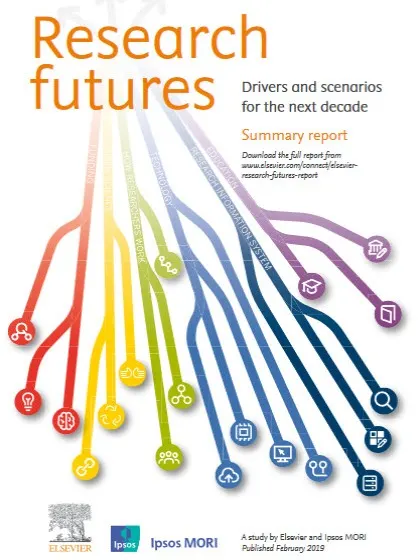
Contributor
